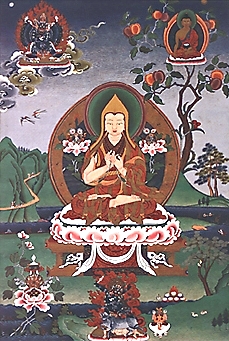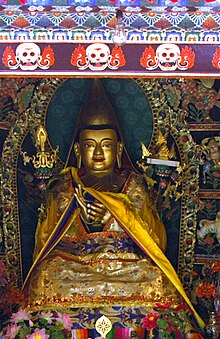


| Je Tsongkhapa | |||||||||||
| Tibetan name | |||||||||||
|---|---|---|---|---|---|---|---|---|---|---|---|
| Tibetan | ཙོང་ཁ་པ། | ||||||||||
| |||||||||||
| Chinese name | |||||||||||
| Traditional Chinese | 宗哥·善慧稱 | ||||||||||
| Simplified Chinese | 宗哥·善慧称 | ||||||||||
| |||||||||||
| Part of a serieson |
| Tibetan Buddhism |
|---|
 |
|
|
|
|
|
Practices and attainment |
|
|
|
Institutional roles |
|
|
|
|
|
|
|
History and overview |
|
|
Tsongkhapa (1357–1419), whose name means “The Man from Onion Valley”, was a famous teacher of Tibetan Buddhism whose activities led to the formation of the Geluk school. He is also known by his ordained name Lobsang Drakpa (blo bzang grags pa) or simply as Je Rinpoche (rje rin po che).
Tsongkhapa heard Buddha’s teachings from masters of all Tibetan Buddhist traditions, and received lineages transmitted in the major schools.[1]
His main source of inspiration was the Kadampa tradition, the legacy of Atiśa. Based on Tsongkhapa’s teaching, the two distinguishing characteristics of the Gelug tradition are:
In his two main treatises (lam rim chen mo and sngags rim chen mo) Tsongkhapa meticulously sets forth this graduated way and how one establishes oneself in the sutric and tantric paths.
By a Mongolian father and a Tibetan mother, Tsongkhapa was born into a nomadic family in Amdo, Tibet in present day Xining prefecture, Gansu province in 1357, Tsongkhapa received the layman ordination (skt. Upasaka) at the age of three from the 4th Karmapa, Rolpe Dorje, and was entitled “Kunga Nyingpo” (kun dga’ snying po). At the age of seven he took the novice ordination (skt. Sramanera, tib. Getsul) from Choje Dhondup Rinchen (chos rje don ’grub rin chen) and was given the name “Lobsang Drakpa” (blo bzang grags pa). It was at this early age that he was able to receive the empowerments of Heruka Chakrasamvara, Hevajra, and Yamantaka, three of the most prominent wrathful deities of Tibetan Buddhism, as well as being able to recite a great many Sutras, not the least of which was Manjushri-nama-samgiti. He would go on to be a great student of the Buddhist Vinaya, the doctrine of behaviour, and even later of the Six Yogas of Naropa, the Kalachakra Tantra, and the acclaimed practice of Mahamudra. At the age of 24 Tsongkhapa received the ordination of a full monk (skt. Bhikshu, tib. Gelong) in the Sakya Tradition.
From Zhönnu Lodrö (gzhon nu blo gros) and Rendawa (red mda’ pa) he received the lineage of the Pramanavarttika transmitted by Sakya Pandita (sa skya pandita).[1] He mastered all the courses of study at Drikung Monastery in Central Tibet.[1]
An emanation of Manjushri, Tsongkhapa is said to be of "one mind" with Atisha, [2] received the Kadam lineages, and studied the major Sarma (gsar ma) Tantras (the Tantras from the “New Translation School”) under Sakya and Kagyü masters.[1] He also studied with Nyingma siddha Legpey Dorje (Wylie: legs gyi rdo rje), and the Zalupa Chökyi-pal (zha lu pa chos kyi dpal),[1] and his main Dzogchen master was Lodrak Drupchen Kekyi Dorje (lho brag grub chen las kyi rdo je), also known as Namkha Gyaltsen (nam mkha' rgyal mtshan, 1326-1401).[3]
In addition to his studies, he engaged in extensive meditation retreats. He is reputed to have performed millions of prostrations, mandala offerings and other forms of purification practice. Tsongkhapa often had visions of meditational deities and especially of Manjushri, with whom he would communicate directly to clarify difficult points of the scriptures.

With the founding of the Ganden monastery in 1409, he laid down the basis for what was later named the Gelug ("virtuous ones") order. At the time of the foundation of the Ganden monastery, his followers became to be known as "Gandenbas." Tsongkhapa himself never announced the establishment of a new monastic order.[4] Tsongkhapa’s teachings drew upon the teachings of Atisha, emphasizing the study of Vinaya, the Tripiṭaka, and the Shastras.[1] Atisha’s Lamrim inspired Tsongkhapa’s Lamrim Chenmo, which became a main text among his followers. He also practised and taught extensively the Vajrayana, and especially how to bring the Sutra and Tantra teachings together, wrote works that summarized the root teachings of the Buddhist philosophical schools, as well as commentaries on the Pratimoksha, Prajnaparamita, Candrakirti’s Madhyamakavatara, logic, and the Sarma Tantras.[1] Tsongkhapa emphasised a strong monastic Sangha.[1] Furthermore, he promoted the study of logic, encouraged formal debates as part of Dharma studies,[1] and instructed disciples in the Guhyasamaja, Kalacakra, and Hevajra Tantras.[1]
Tsongkhapa was one of the foremost authorities of Tibetan Buddhism at the time. He composed a devotional prayer called the Migtsema Prayer to his Sakya master Rendawa, which was offered back to Tsongkhapa, with the note of his master saying that these verses were more applicable to Tsongkhapa than to himself.[5] After Tsongkhapa's passing away, several biographies were written by Lamas of different traditions, and they all agreed that he was a teacher without parallel.[6] The 9th Karmapa, Wangchuk Dorje, praised Tsongkhapa as one "who swept away wrong views with the correct and perfect ones."[6] The 8th Karmapa, Gyalwa Mikyö Dorje, wrote in his poem In Praise of the Incomparable Tsong Khapa:

When the teachings of the Sakya, Kagyue, Kadam
And Nyingma sects in Tibet were declining,
You, O Tsong Khapa, revived Buddha's Doctrine,
Hence I sing this praise to you of Ganden Mountain.[7]
Further, it is said that the Buddha Sakyamuni spoke of his coming as an emanation of the Bodhisattva Manjusri in the short verse from the Root Tantra of Manjushri (Tib. 'Jam-dpal rtsa-rgyud):
After I pass away
And my pure doctrine is absent,
You will appear as an ordinary being,
Performing the deeds of a Buddha
And establishing the Joyful Land, the great Protector,
In the Land of the Snows.[8]
Although Tsongkhapa would finally pass away in 1419 at the age of sixty-two, he left to the world 18 volumes of collected teachings, with the largest amount being on Guhyasamāja tantra. These 18 volumes contain hundreds of titles relating to all aspects of Buddhist teachings and clarify some of the most difficult topics of Sutrayana and Vajrayana teachings.
Major works among them are:
These scriptures are the prime source for the studies of the Gelugpa tradition and these and other teachings of Tsongkhapa endured into the modern age and are seen as a protection against misconceptions in Mahayana and Vajrayana Buddhism. Tsongkhapa's main treatises and commentaries on Madhyamaka are based on the tradition descended from Nagarjuna as elucidated by Buddhapalita and Candrakīrti.

After Tsongkhapa had founded the monastery of Ganden in 1409, it became his main seat. He had many students, among whom Gyaltsab Dharma Rinchen (1364–1431), Khedrup Gelek Pelzang (1385–1438), Togden Jampal Gyatso, Jamyang Choje, Jamchenpa Sherap Senge, and the first Dalai Lama, Gyalwa Gendün Drup (1391–1474), were the most outstanding. After Tsongkhapa’s passing his teachings were held and kept by Gyaltsab Dharma Rinchen and Khedrub Gelek Pälsang. From then on, his lineage has been held by the Ganden Tripas, the throne-holders of Ganden Monastery, among whom the present one is Thubten Nyima Lungtok Tenzin Norbu, the 102nd Ganden Tripa.
After the founding of Ganden Monastery by Tsongkhapa, Drepung Monastery was founded by Jamyang Choje, Sera Monastery was founded by Chöje Shakya Yeshe and the Gendün Drup founded Tashilhunpo Monastery. Many Gelug monasteries were built throughout Tibet but also in China and Mongolia. He spent some time as a hermit in Pabonka Hermitage, which was built during Songsten Gampo times, approximately 8 kilometres north west of Lhasa. Today, it is also part of Sera.
Among the many lineage holders of the Yellow Hat Tradition (Gelugpas) there are the successive incarnations of the Panchen Lama as well as the Chagkya Dorje Chang, Ngachen Könchok Gyaltsen, Kyishö Tulku Tenzin Thrinly, Jamyang Shepa, Phurchok Jampa Rinpoche, Jamyang Dewe Dorje, Takphu Rinpoche, Khachen Yeshe Gyaltsen, Trijang Rinpoche, Domo Geshe Rinpoche,[9] and many others.
The annual Tibetan prayer festival Monlam Prayer Festival was established by Tsongkhapa. There he offered service to ten thousand monks. The establishment of the Great Prayer Festival is seen as one of his Four Great Deeds. It celebrates the miraculous deeds of Buddha Shakyamuni.
Geshe Thupten Jinpa, the translator of the 14th Dalai Lama, notes Tsongkhapa's Madhyamaka deviated from tradition:
"The traditional Geluk understanding of these deviations in Tsongkhapa's thought attributes the development of his distinct reading of Madhyamaka philosophy to a mystical communion he is reported to have had with the bodhisattva Manjusri...It is interesting that the tradition Tsongkhapa is claiming to honour is, in a strict sense, not the existing system in Tibet; rather, it appears to be in the tradition of Manjusri as revealed in a mystic vision!"[10]
Gorampa, a pillar of Sakya thought, insinuated Tsongkhapa conversed with a demon instead of Manjusri:
"Even as serious a scholar as Go rams pa cannot resist suggesting, for example, that Tsong kha pa's supposed conversations with Manjusri may have been a dialogue with a demon instead."[11]
Gorampa accuses Tsongkhapa of being seized by demons and spreading demonic words:
"Gorampa, in the Lta ba ngan sel (Eliminating the Erroneous View), accuses Tsongkhapa of being "seized by demons" (bdud kyis zin pa) and in the Lta ba'i shan 'byed (Distinguishing Views) decries him as a "nihilistic Madhyamika" (dbu ma chad lta ba) who is spreading "demonic words" (bdud kyi tshig)."[12]
Karl Brunnholzl notes that Tsongkhapa's Madhyamaka is not consistent with “any Indian text” or the other Tibetan schools:
"First, with a few exceptions, the majority of books or articles on Madhyamaka by Western - particularly North American - scholars is based on the explanations of the Gelugpa school of Tibetan Buddhism. Deliberately or not, many of these Western presentations give the impression that the Gelugpa system is more or less equivalent to Tibetan Buddhism as such and that this school's way of presenting Madhyamaka is the standard or even the only way to explain this system, which has led to the still widely prevailing assumption that this is actually the case. From the perspective of Indian and Tibetan Buddhism in general, nothing could be more wrong. In fact, the peculiar Gelugpa version of Madhaymaka is a minority position in Indo-Tibetan Buddhism, since its uncommon features are neither found in any Indian text nor accepted by any of the other Tibetan schools."[13]
"All critics of Tsongkhapa, including the Eighth Karmapa, agree that many features of his Centrism are novelties that are not found in any Indian sources and see this as a major flaw."[14]
Sam van Schaik notes that Tsongkhapa "wanted to create something new" and that the early Gandenpas defined themselves by responding to accusations from the established schools:
"Though the Sakya had their own teachings on these subjects, Tsongkhapa was coming to realize that he wanted to create something new, not necessarily a school, but at least a new formulation of the Buddhist Path."[15]
"As Khedrup and later followers of Tsongkhapa hit back at accusations like these, they defined their own philosophical tradition, and this went a long way to drawing a line in the sand between the Gandenpas and the broader Sakya tradition."[16]

| International |
|
|---|---|
| National |
|
| Academics |
|
| People |
|
| Other |
|
| Warning | Local parameters are deprecated. |